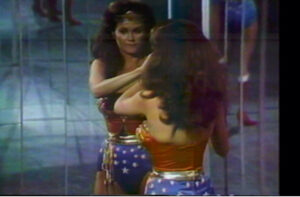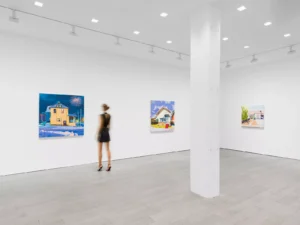Art has long been a tool for both expression and concealment, with many works addressing themes of identity, environment, and perception. In the case of Urban Camouflage: Blue, 2024, Zero Gradient presents a layered and thought-provoking piece that challenges the way we view urban landscapes, anonymity, and the blurred boundaries between visibility and disappearance.
Currently showcased at the Burner International Street Artist Exhibition, this artwork delves into the interplay between camouflage and exposure, particularly in the context of modern cityscapes. The piece stands at the crossroads of street art, digital disruption, and contemporary urban design, making it a critical reflection on both surveillance culture and personal identity within the metropolis.
This essay will explore the conceptual underpinnings of Urban Camouflage: Blue, 2024, analyzing its artistic technique, cultural implications, relationship to Zero Gradient’s broader body of work, and its significance within contemporary art discourse.
The Concept of Camouflage in Art
Camouflage is a practice deeply embedded in military strategy, wildlife survival, and psychological deception, but in contemporary art, it takes on new dimensions. Rather than just a tactic for evasion, camouflage has evolved into a statement about presence, adaptation, and resistance.
In Urban Camouflage: Blue, 2024, Zero Gradient explores camouflage not as an escape, but as a means of merging with the urban fabric. The piece asks:
•How does one remain unseen in an era of hyper-visibility?
•What does it mean to “blend in” within a digitalized urban world?
•Can camouflage be an act of protest against surveillance?
Through strategic use of color, texture, and pattern, the painting reflects on how individuals both exist within and disappear into city landscapes.
Analyzing the Artwork: Composition, Color, and Form
The Role of Blue in Urban Environments
The dominant color in Urban Camouflage: Blue, 2024 is, as the title suggests, blue. But this is not just any blue—it is a spectrum that shifts between:
•Deep navy hues that evoke shadows between skyscrapers.
•Electric neon tones reminiscent of city lights reflecting on wet pavement.
•Muted grays tinged with blue, mimicking the hazy anonymity of distant silhouettes.
The choice of blue is significant because it serves a dual purpose in urban camouflage:
•Blending with reflective glass and steel structures, allowing figures to disappear into mirrored surfaces.
•Contrasting with warmer tones, ensuring that camouflage is not just about invisibility, but about strategic adaptation.
The result is a piece that oscillates between exposure and concealment, forcing the viewer to actively search for hidden details within the composition.
The Texture and Layers of Urban Disguise
Zero Gradient employs a multi-layered painting technique, combining:
•Digital distortion effects that mimic pixelation and surveillance camera interference.
•Spray paint drips and graffiti-inspired textures that link the work to urban street art traditions.
•Fine brushwork in some sections, reminiscent of classical portraiture, challenging the boundaries between abstraction and realism.
The layering creates an illusion of depth and movement, much like an urban cityscape where figures, architecture, and digital screens constantly shift and collide.
Architectural Influence and Geometric Disruption
At its core, Urban Camouflage: Blue, 2024 is a painting that engages with urban design and architecture. The artwork borrows from:
•Brutalist structures that emphasize rigid lines, harsh shadows, and massive concrete expanses.
•Futuristic city grids where buildings blur into one another under neon lights.
•Classic camouflage motifs, but instead of organic woodland patterns, the work incorporates sharp geometric interruptions.
These architectural references reinforce the idea that urban camouflage is not just about color—it is about structure, adaptation, and movement within the built environment.
Thematic Interpretations of the Work
Camouflage as a Response to Surveillance Culture
Modern cities are defined by constant surveillance, from CCTV cameras to AI-driven facial recognition. The question of visibility versus invisibility is no longer just about physical presence—it is about data, algorithms, and the tracking of movement.
Zero Gradient’s artwork speaks directly to this dilemma:
•By blending into the urban environment, does one regain privacy?
•Or does camouflage serve as a metaphor for the erasure of individuality?
Through distorted forms and fragmented compositions, the piece suggests that urban camouflage is both a survival strategy and a method of reclaiming autonomy in a world of digital tracking.
The Intersection of Street Art and Digital Disruption
As part of the Burner International Street Artist Exhibition, Urban Camouflage: Blue, 2024 sits at the intersection of:
•Traditional street art techniques like stencils, graffiti layering, and spray-painting.
•Digital media aesthetics, incorporating glitch effects, pixel sorting, and disrupted imagery.
This fusion aligns with the evolution of street art in the digital age, where artists no longer just paint on walls, but also engage with online spaces, augmented reality, and AI-generated distortions.
The Psychological Experience of Being Unseen
One of the most compelling aspects of Urban Camouflage: Blue, 2024 is its psychological impact. The viewer is constantly shifting between:
•Seeking hidden figures within the abstract layers.
•Experiencing the disorienting sensation of movement within a still image.
•Feeling the push and pull between anonymity and recognition.
This dynamic experience mirrors the real-world tension of existing in a city—the simultaneous desire to be noticed and to remain unseen.
Zero Gradient’s Legacy and Artistic Evolution
Zero Gradient is known for their concept-driven approach to urban aesthetics, exploring themes of:
•Identity and digital distortion
•Camouflage and concealment in contemporary cities
•The relationship between human presence and architectural form
Urban Camouflage: Blue, 2024 marks a pivotal moment in their career, as it synthesizes years of artistic exploration into a single piece that encapsulates the tension between visibility, anonymity, and movement.
Their work has been compared to:
•Banksy (for its urban social commentary).
•Felipe Pantone (for its use of digital disruption and pixelated aesthetics).
•Jenny Holzer (for its critical engagement with surveillance culture).
As Zero Gradient’s profile rises in the global street art and contemporary art scene, their work continues to challenge the way we think about the role of individuals within highly structured environments.
Impression
Urban Camouflage: Blue, 2024 is more than just a painting—it is a commentary on the modern world. It examines how people navigate hyper-surveilled cityscapes, how they use camouflage as both protection and expression, and how the digital age has altered our sense of presence and identity.
The artwork’s placement in the Burner International Street Artist Exhibition is crucial, as it bridges the gap between street art’s rebellious origins and its place within contemporary galleries.
At a time when urban environments are becoming increasingly automated, digitized, and monitored, Zero Gradient’s work serves as a reminder that art still has the power to disrupt, conceal, and challenge.
No comments yet.








